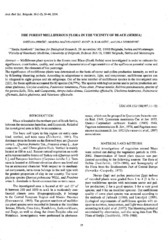Приказ основних података о документу
Šumska medonosna flora okoline Blaca, Srbija
The forest melliferous flora in the vicinity of Blace, Serbia
| dc.creator | Perišić, Snežana | |
| dc.creator | Mačukanović-Jocić, Marina P. | |
| dc.creator | Karadžić, Branko | |
| dc.creator | Đurđević, Lola | |
| dc.date.accessioned | 2015-08-28T10:26:51Z | |
| dc.date.available | 2015-08-28T10:26:51Z | |
| dc.date.issued | 2004 | sr |
| dc.date.issued | 2004 | |
| dc.identifier.issn | 0354-4664 | sr |
| dc.identifier.other | Rad_konverzija_180 | sr |
| dc.identifier.uri | https://radar.ibiss.bg.ac.rs/handle/123456789/101 | |
| dc.description.abstract | Melliferous plant species in the forests near Blace (South Serbia) were investigated in order to estimate the significance, contribution, quality and ecological characteristics of representatives of the apiflora as potential nectar and pollen sources, the elements of bee pasturage. The significance of melliferous plants was determined on the basis of nectar and pollen production intensity, as well as by following blooming periods. According to adaptations to moisture, light, and temperature, melliferous species can be relegated to eight groups and six subgroups. Out of the total number of melliferous species in the investigated area (223), the forest apiflora accounted for 82 species (36,77%). The species with highest nectar and/or pollen production are: Alnus glutinosa, Corylus avellana, Paulownia tomentosa, Picea abies, Prunus tenella, Robinia pseudoacacia, species of the genera Salix, Tilia, and Campanula, Atropa bella-donna, Calamintha officinalis, Glechoma hederacea, Pulmonaria officinalis, Salvia glutinosa and Valeriana officinalis. | en |
| dc.description.abstract | Florističkim istraživanjima okoline Blaca (livade, pašnjaci, šume, ruderalna i močvarna staništa), zabeleženo je 488 vrsta, od kojih su 223 (45,7%) medonosne, Od ovog broja, šumsku apifloru čine 82 vrste tj. 36,8% (61 drvenasta i 21 zeljasta). S obzirom na medni potencijal (najveći indeksi nektarske ili polenske produkcije), veliku brojnu zastupljenost kao i period cvetanja, najveći značaj za pčelinju pašu imaju sledeće šumske vrste: Acer tataricum, Alnus glutinosa, Castanea sativa, Corylus avelana, Juglans regia Salix babilonica, Robinia pseudoacacia, Tilia cordata, Pulmonaria officinalis, Salvia glutinosa i Glechoma hederacea. Analizom vlažnosti staništa, može se zaključiti da najveći broj vrsta sa istraživanog područja pripada ekološkoj grupi submezofita (56,1%). Prema svetlosnim uslovima na staništima u okolini Blaca, većina medonosnih šumskih vrsta su poluskiofite (61%), a u odnosu na temperaturu, 50 % su mezotermne vrste. | sr |
| dc.description.sponsorship | null | sr |
| dc.language.iso | eng | sr |
| dc.rights | openAccess | sr |
| dc.source | Archives of Biological Sciences | sr |
| dc.title | Šumska medonosna flora okoline Blaca, Srbija | sr |
| dc.title | The forest melliferous flora in the vicinity of Blace, Serbia | en |
| dc.type | article | sr |
| dc.rights.license | ARR | |
| dcterms.abstract | Перишић, Снежана; Мачукановић-Јоцић, Марина П.; Ђурђевић, Лола; Караджић, Бранко; Шумска медоносна флора околине Блаца, Србија; Шумска медоносна флора околине Блаца, Србија; | |
| dc.citation.issue | 1-2 | sr |
| dc.citation.volume | 56 | sr |
| dc.citation.spage | 39 | sr |
| dc.citation.epage | 44 | sr |
| dc.type.version | publishedVersion | sr |
| dc.identifier.fulltext | https://radar.ibiss.bg.ac.rs//bitstream/id/1827/Rad_konverzija_180.pdf | |
| dc.identifier.rcub | https://hdl.handle.net/21.15107/rcub_ibiss_101 |

